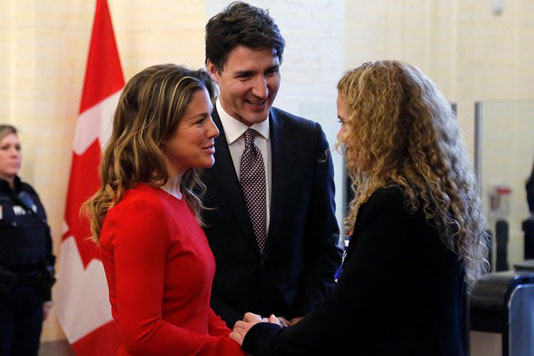OTTAWA, Dec 6, 2019 (BSS/AFP) – Canadian Prime Minister Justin Trudeau
unveiled a legislative agenda on Thursday that touts tax cuts and tougher
climate actions in the first test of his new minority government.
After a nasty election fight and his rejection of a formal coalition,
Trudeau must rely on the backing of opposition parties on a case-by-case
basis to stay in power.
That starts with garnering support for his agenda, which was outlined in a
throne speech by Governor General Julie Payette to parliament, convened for
the first time since the October ballot.
In the 30-minute address Payette sketched out plans for tax cuts, net-zero
CO2 emissions by 2050, implementation of the UN Declaration on the Rights of
Indigenous Peoples, a ban on assault rifles, and a national prescription drug
plan.
“We know that we are inextricably bound to the same space-time continuum
and on board the same planetary spaceship,” said the former astronaut.
“I am certain that by working together, no challenges are too big.”
One key opposition leader, however, said the priorities laid out by the
government did not go far enough.
Trudeau has just returned from NATO talks where a hot mic gaffe revived his
feud with US President Donald Trump.
Trump branded him “two-faced” after allied leaders were caught on video at
a Buckingham Palace reception mocking the American president’s rambling press
appearances.
The Canadian leader insisted it won’t complicate relations, including
ratification of a continental trade deal with the United States and Mexico.
But opposition parties tarred Trudeau for “weakening” Canada abroad with
such “high school gossip.”
– Keep opponents close –
After a poor performance during the campaign that dredged up an ethics
scandal and embarrassing photos of a young Trudeau in blackface, the Canadian
leader has kept a low profile, meeting privately with opposition leaders and
stakeholders to try to find common ground.
It’s a change from his first term when the debonair politician exploded
onto the world stage as a strong liberal voice and a counterbalance to the
rising political right, declaring: “Canada is back!”
The laundry list of looming issues is also longer and more complex than
four years ago — including a slowing economy and geographic political
divisions.
Canadians “sent us here with clear instructions to work together to make
life better for them,” Trudeau told lawmakers earlier.
“Common ground does exist in this parliament and I know we can build on
it,” he said.
There have been only 14 minority governments in Canadian history, the last
in 2009.
Few have lasted more than two years, but they can be productive, having
resulted in universal healthcare, a national pension plan and the maple leaf
flag.
Canada’s 43rd parliament will be “a real test” of Trudeau’s leadership,
Lori Williams, a politics professor at Mount Royal University in Calgary,
told AFP.
“He’ll need to be willing to make compromises.”
After a debate over the coming days or weeks, lawmakers will vote on
whether to accept the government’s plans, or not, and trigger snap elections.
Most observers agree the government won’t fall in the near term because the
opposition is in turmoil.
Conservative leader Andrew Scheer is facing pressure to resign and the New
Democratic Party (NDP) has no money to fight another election right now.
The Liberals must also regroup and rebuild after losing 20 seats.
And, according to Williams, “Canadians have no interest in going back to
the polls anytime soon.”
Over this stretch, support for the Liberals is most likely to come from the
left-leaning NDP as the two parties are broadly aligned on policies.
NDP leader Jagmeet Singh, however, after demanding bold measures “to really
make a difference in peoples’ lives,” said he was disappointed by what he
heard in the throne speech.
“We want to work together, but what they’ve offered so far is not
sufficient,” he said.



